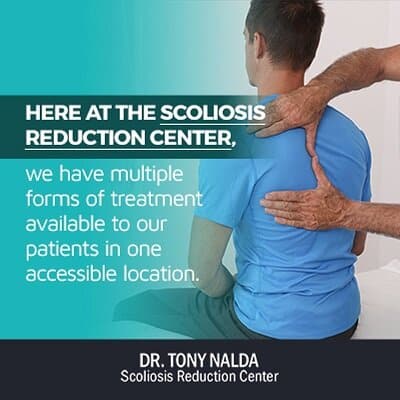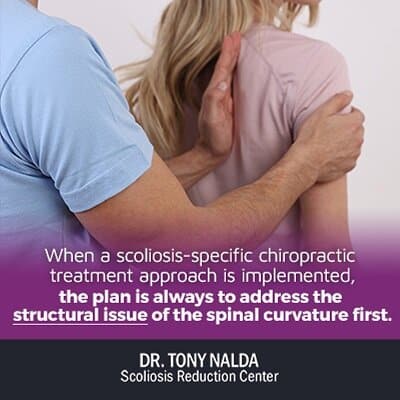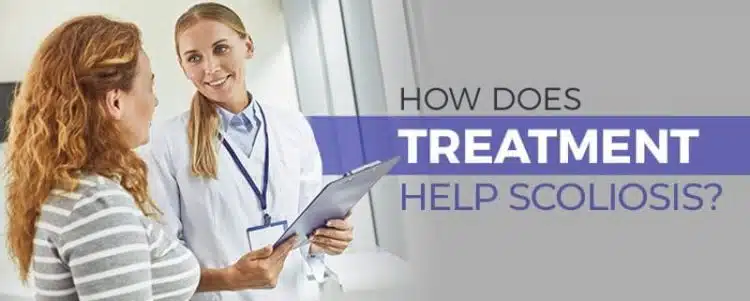As a progressive condition with no known cure, choosing how to treat your scoliosis is a crucial decision. There are different approaches to treatment, but a functional scoliosis-specific chiropractic approach can treat the actual condition and not just its symptoms.
Receiving a Scoliosis Diagnosis
When I give a patient a scoliosis diagnosis, understandably, those patients have a lot of questions. Most often, they want to know what caused their condition, if it will get worse, and how much worse it’s going to get.
These are tough questions to face because when it comes to cause, 80 percent of diagnosed cases have no known cause. As to whether or not it will get worse, there’s no definitive way to know the answer to this question, but in most cases, at some point, scoliosis will progress as it’s in its nature to do so. There is also no way to know exactly how much worse a patient’s condition will get.
Two patients of the same age and condition form, with similar characteristics, can both start off with a 10-degree curve, but one might only progress to 20 degrees while the other can progress rapidly to 30 degrees or more.
While there are certain triggers for and patterns of progression to watch for, such as growth, all we can do is develop a treatment approach that counteracts the condition’s natural tendency to worsen over time.
As a complex and often unpredictable condition, choosing an effective scoliosis-treatment plan is very important. Anyone who promises to ‘cure’ your scoliosis doesn’t fully understand the condition; no one can cure scoliosis. We can, however, take a number of treatment approaches to positively manage and slow its progression.
How Condition Classification Informs Treatment
As a spinal deformity, scoliosis is an abnormal sideways curvature of the spine that coincides with spinal rotation. It’s a 3-D condition that can range from mild to severe, depending on the Cobb angle measurement.
The Cobb angle measurement is taken via X-ray and measures the degree of the spinal curvature by looking at the most tilted vertebrae at the apex of the curve. Once a patient has their Cobb angle measurement, their condition will be classed as mild, moderate, or severe.
This classification is important because combined with other factors such as where along the spine the curvature is located, the age of the patient, and the condition’s cause (if known), the Cobb angle tells us what we need to know about a patient’s condition so we can move forward with a customized treatment plan.
Treating Scoliosis as a Condition

Here at the Scoliosis Reduction Center®, we have multiple forms of treatment available to our patients in one accessible location. Our scoliosis specialists truly understand the condition and all its complexities. We understand that there is no one-size-fits-all treatment option as the condition and its symptoms vary so greatly from one patient to the next.
Our first priority with any treatment plan is to first address the structural issue of the curvature. Once we develop a plan to reduce the spinal curvature to a corrective position and we see that it’s working, we widen our treatment plan to include a number of effective exercises and stretches that patients can do at home to augment those results.
Through scoliosis-specific chiropractic care and adjustments, we can actually get the spine to move in the direction we want it to, and by using a functional approach, that corrective position is achieved naturally, and not at the expense of function or flexibility.
In this respect, we’re addressing the actual condition as the curvature is a symptom of the underlying causes of scoliosis. While we don’t know many of those causes, we can treat the structural deformity, the condition itself, rather than just treat symptoms of the curvature, such as pain.
Once we’ve addressed the structural issues of the curvature, we also provide our patients with guidance on how to make other scoliosis-friendly changes to their lifestyles. These changes can involve diet, scoliosis-specific exercises, and recommendations for the types of activities that people with scoliosis should avoid and which ones can be beneficial.
These recommendations, on their own, wouldn’t address the structural issues, but combined, they can help strengthen the mind and body to better deal with the rigors of the condition and treatment.
Treating Scoliosis as a Symptom
If a person with scoliosis has decided to either forego treatment or take a passive traditional approach based on observation rather than proactive treatment, it’s likely that their condition will progress more rapidly.
Often, in these cases, once the condition progresses in severity and starts to produce symptoms such as pain and discomfort, this is when the patient might visit their GP for treatment.
The problem with this approach is going to see a GP for pain management is not scoliosis-specific. A doctor will likely respond in the same way they would with pain in a number of conditions or medical issues: with pain medication or injections.
The danger with this, when it comes to scoliosis, is that pain medication and injections are only treating the condition as a symptom, and not the condition itself. This approach is doing nothing to actually address the structural issue causing the pain and is only addressing the pain itself.
While pain management and relief is important, it can actually hide the fact that a person’s scoliosis is progressing. With scoliosis, the sooner treatment is started, the easier it is to control its progression; the longer a condition is left to progress unimpeded, the harder it is to correct, the harder the patient will have to work, and the more likely it is that that the condition will start producing other symptoms.
The Scoliosis Reduction Center® Approach
As I mentioned earlier, here at the Scoliosis Reduction Center®, our team is made up of experts from a wide range of disciplines; this makes us that much more able to fully customize a treatment plan.
Just as scoliosis can take many forms and its symptoms range across a wide spectrum, no two treatment plans we design are ever the same. In fact, I can honestly say that in all my years of treating scoliosis, I’ve never treated two patients the exact same way.
We work closely with our patients and their caregivers to come up with a treatment plan that’s effective, sustainable, and draws on the benefits of multiple forms of treatment: scoliosis-specific chiropractic, therapy and rehabilitation, and custom 3-D bracing.
Scoliosis-Specific Chiropractic Treatment

As a form of alternative medicine that deals with diagnosing and treating mechanical disorders of the musculoskeletal system, chiropractic that’s aimed specifically at treating scoliosis couples a comprehensive understanding of the spine with how it’s affected by an abnormal curvature.
When a scoliosis-specific chiropractic treatment approach is implemented, the plan is always to address the structural issue of the spinal curvature first. Through a series of chiropractic adjustments and augmenting those with scoliosis-specific exercises, we can make the spine move how we want it to, reducing the curvature, and thereby relieving resulting symptoms such as pain and discomfort.
The alternative to this approach is far more invasive and involves using spinal-fusion surgery to force the spine into a straighter alignment. The difference here is with surgery, the spine is being rigidly held in place by hardware such as rods, screws and wires. While strictly in terms of making a crooked spine straighter, spinal-fusion can be seen as a successful treatment, when it comes to living with a spine that’s ‘held’ in place through artificial means rather than ‘corrected’ through natural means, that comes at the cost of function.
Through scoliosis-specific chiropractic, we can actually strengthen the spine so that it can better support itself and is less likely to shift out of alignment.
Ultimately, it comes down to what you want your life with scoliosis to look like. If you don’t want the concern of what a spine that’s undergone spinal-fusion surgery can handle and that fear of something going wrong with the hardware or needing subsequent surgeries down the road, there are other positive treatment options available.
Therapy and Rehabilitation
Therapy and rehabilitation that’s scoliosis-specific can help people living with scoliosis in a number of ways. Here at the Scoliosis Reduction Center®, we understand that traditional forms of therapy and rehabilitation that are effective for a number of back issues need to be modified to address the complexities of scoliosis.
Our scoliosis-specific therapy works to passively mobilize the spine in a corrective position. This approach combines a number of treatment options, all available here at the center, such as vibration, de-rotation, traction, and the use of equipment such as the scoliosis traction chair, scoliosis flexion distraction table, and the thoracic mechanical drop piece.
While traditional rehabilitation takes place over long periods of time, scoliosis-specific rehabilitation increases in intensity for the best results, meaning an intense amount of treatment in a shorter period of time.
Scoliosis-Specific Exercises
General exercises can do little to benefit a patient’s scoliosis specifically, but exercises that are scoliosis-specific can work to stabilize the spine by strengthening the surrounding muscles the spine relies on for support.
These exercises will be adjusted and customized to suit the patient’s individual curvature, condition type, and scoliosis-related symptoms and include active movement, isometric exercises, and reflexive exercises.
We are certified in SEAS (Scientific Exercise Approach to Scoliosis), an exercise approach based on active self-correction techniques with functional results.
When done consistently and correctly, these exercises can help stabilize the spine and improve posture, balance, and coordination.
Custom 3-D Bracing
Using bracing to help treat scoliosis isn’t a new concept, but traditional bracing’s not the same as the custom 3-D bracing we use here at the Scoliosis Reduction Center®.
As I mentioned earlier, scoliosis is a 3-D condition, meaning that in order for any treatment plan to be effective, it has to address the condition on all three planes it exists on: frontal, sagittal, and transverse.
Traditional braces like the Milwaukee and the Boston Brace are mass-produced and only ‘hold’ the spine in a corrective position; they do nothing for reducing the curvature. In fact, these types of braces are providing a 2-dimensional solution to a 3-dimensional condition.
It was clear to me that the treatment approach with bracing had to be improved upon. Our ScoliBrace® is the answer; it’s custom manufactured to address the individuality of each patient’s curvature, body type, flexibility level, and condition. It’s designed to reduce the curvature while it’s being worn.
Rather than just holding the spine in a straighter alignment, our ScoliBrace® works by actually reducing the curvature in a corrective position. Thanks to state of the art imaging software, we are able to scan patients to ensure their brace is 100-percent bespoke to their body and condition type.
Conclusion
When someone faces a scoliosis diagnosis, there are a lot of accompanying emotions. Patients wonder what living with the condition will mean for their every-day lives and, of course, want to know how much worse it can get. It’s difficult to look into the eyes of a young patient and their caregivers and tell them I don’t have those answers but that, most likely, the condition will get worse.
While I can’t offer patients the promise of a treatment for their scoliosis that will cure it, because that simply doesn’t exist, what I can offer them is an alternative treatment path with proven results.
Here at the Scoliosis Reduction Center®, our scoliosis specialists come from a wide range of disciplines. I’m thrilled to be able to offer my patients multiple forms of treatment in one accessible location. Through scoliosis-specific chiropractic care, therapy and rehabilitation, scoliosis-specific exercises, and custom 3-D bracing, we work with our patients to come up with treatment plans that are effective, sustainable, and allow them to live their best lives during and post-treatment.





